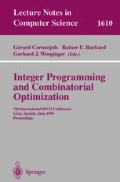Abstract
At the IPCO VI conference Cornuéjols and Dawande proposed a set of 0– 1 linear programming instances that proved to be very hard to solve by traditional methods, and in particular by linear programming based branch-and-bound. They offered these market split instances as a challenge to the integer programming community. The market split problem can be formulated as a system of linear diophantine equations in 0–1 variables.
In our study we use the algorithm of (1998) based on lattice basis reduction. This algorithm is not restricted to deal with market split instances only but is a general method for solving systems of linear diophantine equations with bounds on the variables.
We show computational results from solving both feasibility and optimization versions of the market split instances with up to 7 equations and 60 variables, and discuss various branching strategies and their effect on the number of nodes enumerated. To our knowledge, the largest feasibility and optimization instances solved before have 6 equations and 50 variables, and 4 equations and 30 variables respectively.
We also present a probabilistic analysis describing how to compute the probability of generating infeasible market split instances. The formula used by Cornuéjols and Dawande tends to produce relatively many feasible instances for sizes larger than 5 equations and 40 variables.
Research partially supported by the ESPRIT Long Term Research Project nr. 20244 (Project ALCOM-IT: Algorithms and Complexity in Information Technology), by the project TMR-DONET nr. ERB FMRX-CT98-0202, both of the European Community, and by NSF through the Center for Research on Parallel Computation, Rice University, under Cooperative Agreement No. CCR-9120008.
Research partially supported by the project TMR-DONET nr. ERB FMRX-CT98-0202 of the European Community.
Research partially supported by the ESPRIT Long Term Research Project nr. 20244 (Project ALCOM-IT: Algorithms and Complexity in Information Technology), and by the project TMR-DONET nr. ERB FMRX-CT98-0202, both of the European Community.
Access this chapter
Tax calculation will be finalised at checkout
Purchases are for personal use only
Preview
Unable to display preview. Download preview PDF.
References
K. Aardal, C. Hurkens, A. K. Lenstra (1998). Solving a system of diophantine equation with lower and upper bounds on the variables. Research report UU-CS-1998-36, Department of Computer Science, Utrecht University.
G. Cornuéjols, M. Dawande (1998). A class of hard small 0–1 programs. In: R. E. Bixby, E. A. Boyd, R. Z. Ríos-Mercado (eds.) Integer Programming and Combinatorial Optimization, 6th International IPCO Conference. Lecture Notes in Computer Science 1412, pp 284–293, Springer-Verlag, Berlin Heidelberg.
CPLEX 6.0 Documentation Supplement (1998). ILOG Inc., CPLEX Division, Incline Village NV.
CPLEX 6.5 Documentation Supplement (1999). ILOG Inc., CPLEX Division, Incline Village NV.
G. R. Grimmett, D. R. Stirzaker (1982). Probability and Random Processes, Oxford University Press, Oxford.
A. K. Lenstra, H. W. Lenstra, Jr., L. Lovász (1982). Factoring polynomials with rational coefficients. Mathematische Annalen 261, 515–534.
H. W. Lenstra, Jr. (1983). Integer programming with a fixed number of variables. Mathematics of Operations Research 8, 538–548.
LiDIA — A library for computational number theory. TH Darmstadt / Universität des Saarlandes, Fachbereich Informatik, Institut für Theoretische Informatik. http://www.informatik.th-darmstadt.de/pub/TI/LiDIA
L. Lovász, H. E. Scarf (1992). The generalized basis reduction algorithm. Mathematics of Operations Research 17, 751–764.
A. Schrijver (1986). Theory of Integer and Linear Programming. Wiley, Chichester.
A. M. Verweij (1998). The UHFCO Library. Department of Computer Science, Utrecht University.
Author information
Authors and Affiliations
Editor information
Editors and Affiliations
Rights and permissions
Copyright information
© 1999 Springer-Verlag Berlin Heidelberg
About this paper
Cite this paper
Aardal, K., Bixby, R.E., Hurkens, C.A.J., Lenstra, A.K., Smeltink, J.W. (1999). Market Split and Basis Reduction: Towards a Solution of the Cornuéjols-Dawande Instances. In: Cornuéjols, G., Burkard, R.E., Woeginger, G.J. (eds) Integer Programming and Combinatorial Optimization. IPCO 1999. Lecture Notes in Computer Science, vol 1610. Springer, Berlin, Heidelberg. https://doi.org/10.1007/3-540-48777-8_1
Download citation
DOI: https://doi.org/10.1007/3-540-48777-8_1
Published:
Publisher Name: Springer, Berlin, Heidelberg
Print ISBN: 978-3-540-66019-4
Online ISBN: 978-3-540-48777-7
eBook Packages: Springer Book Archive

